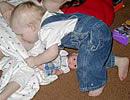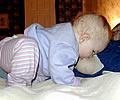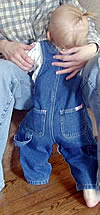
© 2005 P. Yount
Kneading, patting, twiddling, scratching, pinching, grabbing mom’s nose, biting, pulling at mom’s shirt, playing with or pulling mom’s hair, blowing raspberries on mom’s breast, breastfeeding standing up, breastfeeding upside down, acrobatic breastfeeding…
Does any of this sound familiar??

© 2005 P. Yount
All of these things are very normal breastfeeding behaviors for older babies and toddlers. Many things children do when they are breastfeeding are cute or downright funny – but what if it’s a behavior that you don’t like? However normal it may be, there is no reason mom has to put up with behaviors that are painful or annoying when breastfeeding.
Now infants can get
all their vitamin D
from their mothers’ milk;
no drops needed with
our sponsor's
TheraNatal Lactation Complete
by THERALOGIX. Use PRC code “KELLY” for a special discount!
Tips for curbing unwanted breastfeeding behavior:
Start early

© 2005 P. Yount
Encourage good breastfeeding manners and discourage unwanted behavior early on. For example, many mothers start using a code word for breastfeeding long before baby is talking, and even a very young baby can learn not to bite when nursing.
Be firm, clear and consistent with your expectations.
Be patient
Behavior changes take time.
Wait it out

© 2005 P. Yount
Many breastfeeding behaviors are a phase, where your child is experimenting with what he can do while breastfeeding. If a particular behavior is only mildly annoying, then one option is to wait for a bit to see if the novelty wears off on its own.
Distract and Redirect
- Find another way to occupy your child’s hands. Suggest he touch his own body or clothes instead of yours. Show him how he can rub your arm rather than pinch it. Try holding hands, tickling/kissing/blowing on his hand, playing finger games, counting fingers, having him point to different things, clapping, etc.
- Give your child something to hold and play with while nursing (a small toy, blanket, etc.). If your child isn’t interested in the first thing you try, try different sizes and textures (hard, soft, textured, silky). If your child wants to play with your hair, or your nose, or the other breast, then try to find something of a similar texture or size that might serve as a reasonable substitute.
- Wear a nursing necklace or bright scarf to redirect your child’s attention.
- Talk, read a book or tell a story to your child while you nurse. Songs or finger plays can also be fun.
Gently discourage unwanted behavior
-

© 2005 P. Yount
If your child plays with the opposite nipple/breast (often called “twiddling”), try wearing a bra or other clothing that is not easily accessible, or covering the opposite breast with your hand or arm. Combine this with distraction and redirection as discussed above.
- Consider a firm reprimand: “Be still” or “Keep Mommy covered” or “If you keep doing that we will stop nursing.” Use a firm voice but not so firm that it scares your child. You might also hug your child close to you or hold his hand to reiterate the point.
- Stop breastfeeding if your child continues and explain in a few simple words why you stopped nursing. Say something like “I can’t nurse you when you’re squirmy. Let’s go play and get the wiggles out and we will nurse in a little while.” Offer to nurse again in a few minutes, or wait until your child asks to nurse again.
Avoid the more difficult situations

© 2005 P. Yount
Some children go through a stage where breastfeeding in public can be a problem. Perhaps your child is really distractible or wiggly, or insists on flapping your shirt up and down.
If your child needs to breastfeed but will not settle down for nursing, try offering a snack or a little water or other beverage from a cup. If you’re uncomfortable breastfeeding in public, try to nurse before leaving home and tell your child that you’ll nurse as soon as you get to a more private spot (delaying breastfeeding like this works better when baby is over 18 months and is not overtired).
Before you leave home, discuss with your child what behavior you expect from him when you’re out. For instance if he tends to pull your shirt up, ask his help in keeping you covered while you’re out.
Is it okay to have different “rules” for breastfeeding when you are at home than when you are in public?

© 2005 P. Yount
Absolutely! There are many situations where we have different expectations for public or private behavior, and breastfeeding is simply another of these. There is a time and a place for acrobatic breastfeeding, but for the majority of moms, it’s not when they are nursing in public. Many moms allow their nurslings to be creative at home, but require breastfeeding behavior that is more modest and sedate when they are out in public. Most children adapt pretty easily to rules that are different in different situations. If your child is having problems with the double standard, however, try keeping the rules more consistent until he is a little older.
Do you have concerns about the way your child asks to breastfeed, particularly in public?

© 2005 P. Yount
Does he pull on your shirt, stick his hand down your shirt, or ask loudly to breastfeed? Or are you afraid that he will in the future? Try incorporating a “code word” for breastfeeding and/or teaching your child a sign for breastfeeding–many mothers do this long before their child becomes verbal. Depending on the child’s age and the situation, many mothers will only breastfeed if their child asks in an acceptable manner. Model to your child acceptable ways to ask to breastfeed, and practice with him.
Read more:
Toddler nursing: What to expect (includes more on acrobatic nursing)
@ other websites
Is That OK? (nipple twiddling during breastfeeding) by Shel Franco
Toddler Tips: Incredible Acrobatic Nursing Feats from the LLLI website
